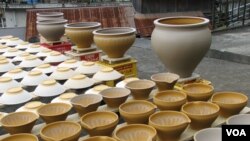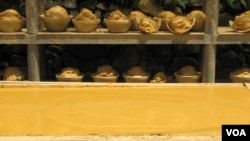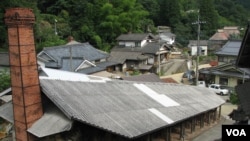The mix of an Irish anthropologist with an interest in pottery, a small southern village in Japan and plenty of sake or rice wine to drink would inevitably produce none other than a great story. It is indeed told in the book Folk Art Potters in Japan. Brian Moeran has had a long and distinguished career as a Professor of Social Anthropology at Copenhagen Business School and part time at the University of Hong Kong. He is the author of many books, but his account of potters in Japan, with a focus on the Japanese Mingei movement or the field of "folk art" is especially interesting in terms of the style of pottery itself, the hidden social structure of the village that defined the ways of the craft, and the surprise British influence nearly a century ago. Professor Moeran tells us more from Hong Kong.
STEVENSON: This looks like a very interesting book, a very specific topic you normally do not see on the shelves in book stores.
MOERAN: It is decently written and it doesn’t have jargon. But it is an academic book. I am an anthropologist. We like to go and do things with the people we are studying. So when it came to potters, I went to a pottery village in the south of Japan and stayed there for two years. There were only 14 houses. Ten houses made pots, [there were] 82 people. I got to know them pretty well and they got to know me pretty well. In order to get my information for the most part, I had to spend an awful lot of time drinking sake, Japanese rice wine, with the potters. Potters tend to drink a lot. The reason I had to drink was that when we were drinking, the potters would tell me all the things that they never told me during the daytime. So I had two kinds of information. One was the public story that went on during the daytime when they would answer my questions quite frankly but also holding back. And so they would tend to give me the official version of their life. When it was nighttime and we started drinking, then they would start to tell me all the things that were really going on behind the scenes. That was quite amusing but not very good for my liver.
STEVENSON: This is the village of Sarayama, correct?
MOERAN: That is right. Sarayama is a very common name in the south of Japan. It just means “plate mountain.” It refers to where clay is dug. The one I was staying at was named Sarayama Onta. I was looking at the Japanese folk art movement which was led by a gentleman called Yanagi So etsu. Back in the 1920s, they came up with this notion of folk art, which they called Mingei. One other person who was involved, very importantly, was the British potter Bernard Leach, sort of the courier or cultural intermediary between Europe and the Orient, and made [Japanese] folk art famous in both Europe and America.
STEVENSON: You have written this book essentially twice because you have updated it. What were some of the differences that you found as you were doing it the second time?
MOERAN: The second time I did not go back there. I updated more in terms of theoretical developments that had taken place in anthropology and sociology of art. But I did a few years after that and was really quite surprised. The village as a whole and Onta pottery has now been designated an important intangible cultural property by the Japanese government. They are not allowed to change [the way they make pottery and adapt to current trends]. The market demand has totally changed. When I was there, there was what is known as the Mingei boom. Tourism was centered on going around different folk art villages. That finished by the 1980s. In the beginning of this new millennium, the demand fell away totally. So the potters at the moment are really disappointed and don’t know what to do. It could well be that the whole traditional way of doing things will actually disintegrate within the next generation unless market demand somehow picks up.
STEVENSON: This looks like a very interesting book, a very specific topic you normally do not see on the shelves in book stores.
MOERAN: It is decently written and it doesn’t have jargon. But it is an academic book. I am an anthropologist. We like to go and do things with the people we are studying. So when it came to potters, I went to a pottery village in the south of Japan and stayed there for two years. There were only 14 houses. Ten houses made pots, [there were] 82 people. I got to know them pretty well and they got to know me pretty well. In order to get my information for the most part, I had to spend an awful lot of time drinking sake, Japanese rice wine, with the potters. Potters tend to drink a lot. The reason I had to drink was that when we were drinking, the potters would tell me all the things that they never told me during the daytime. So I had two kinds of information. One was the public story that went on during the daytime when they would answer my questions quite frankly but also holding back. And so they would tend to give me the official version of their life. When it was nighttime and we started drinking, then they would start to tell me all the things that were really going on behind the scenes. That was quite amusing but not very good for my liver.
STEVENSON: This is the village of Sarayama, correct?
MOERAN: That is right. Sarayama is a very common name in the south of Japan. It just means “plate mountain.” It refers to where clay is dug. The one I was staying at was named Sarayama Onta. I was looking at the Japanese folk art movement which was led by a gentleman called Yanagi So etsu. Back in the 1920s, they came up with this notion of folk art, which they called Mingei. One other person who was involved, very importantly, was the British potter Bernard Leach, sort of the courier or cultural intermediary between Europe and the Orient, and made [Japanese] folk art famous in both Europe and America.
STEVENSON: You have written this book essentially twice because you have updated it. What were some of the differences that you found as you were doing it the second time?
MOERAN: The second time I did not go back there. I updated more in terms of theoretical developments that had taken place in anthropology and sociology of art. But I did a few years after that and was really quite surprised. The village as a whole and Onta pottery has now been designated an important intangible cultural property by the Japanese government. They are not allowed to change [the way they make pottery and adapt to current trends]. The market demand has totally changed. When I was there, there was what is known as the Mingei boom. Tourism was centered on going around different folk art villages. That finished by the 1980s. In the beginning of this new millennium, the demand fell away totally. So the potters at the moment are really disappointed and don’t know what to do. It could well be that the whole traditional way of doing things will actually disintegrate within the next generation unless market demand somehow picks up.










